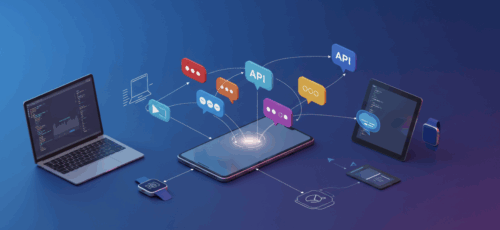Choosing the right programmable voice API requires evaluating accuracy, scalability, pricing, and integration complexity across multiple providers.
- Technical Performance: Assess accuracy rates, latency, and real-time processing capabilities to ensure reliable voice communication
- Business Factors: Compare pricing models, support quality, and scalability options to match budget and growth requirements
- Integration Requirements: Evaluate SDK quality, documentation, and security features for seamless development workflows
- Future-Proofing: Consider AI capabilities, global reach, and carrier redundancy to build resilient voice applications
Start with a requirements assessment, then use our decision matrix to systematically compare providers.
The global voice and speech recognition market reached $20.25 billion in 2023 and is projected to grow at a remarkable 14.6% CAGR through 2030, driven by the rapid adoption of AI-powered communication technologies. For developers building modern applications, selecting the right programmable voice API comparison framework helps in delivering scalable, reliable voice experiences that meet evolving user expectations.
Voice API providers now offer sophisticated capabilities, including real-time transcription, sentiment analysis, and AI-driven automation. However, this expanded feature set also introduces complexity in the evaluation process. A comprehensive 2024 developer survey revealed that 90% of developers rely on API documentation as their primary learning resource, highlighting the importance of thorough voice API evaluation before implementation.
The choice between voice API providers can impact development velocity, operational costs, and long-term scalability. Whether you’re building customer service platforms, healthcare applications, or communication tools, understanding the core evaluation criteria enables informed decision-making that aligns technical capabilities with business objectives.
What Makes a Programmable Voice API Essential for Modern Applications?
Voice communication remains fundamental to business operations, with more than 76% of consumers preferring traditional phone calls to reach customer support representatives. Modern programmable voice APIs bridge the gap between traditional telephony infrastructure and cloud-native applications, enabling developers to integrate voice capabilities without managing complex carrier relationships or maintaining legacy hardware.
The shift toward cloud-based communication solutions reflects broader digital transformation trends. Applications now require voice functionality that scales dynamically, supports global reach, and integrates seamlessly with existing software architectures. Voice APIs simplify telephony complexity while providing granular control over call flows, routing logic, and real-time processing.
Voice API evaluation becomes particularly important as businesses adopt omnichannel communication strategies. Applications must handle voice interactions alongside chat, email, and messaging within unified customer experiences. The right voice API provider offers comprehensive communication tools that support diverse use cases from automated customer service to secure enterprise communications.
Essential Evaluation Criteria for Voice API Selection
A successful programmable voice API comparison requires a systematic assessment across technical, operational, and strategic dimensions. Each criterion directly impacts application performance, development efficiency, and long-term viability in production environments.
Technical Performance Metrics
Voice quality and reliability form the foundation of any voice API implementation. Evaluate providers based on call completion rates, audio quality consistency, and latency performance across different geographic regions. Real-time processing capabilities determine whether applications can handle live transcription, sentiment analysis, or dynamic call routing without introducing delays that degrade user experience.
Network infrastructure impacts performance consistency. Providers with direct carrier relationships and redundant routing typically deliver superior call quality compared to those relying on gray routes or third-party aggregators. The ITU-T G.114 standard recommends no more than 150ms of one-way latency for acceptable voice communication quality.
Accuracy metrics become critical for applications incorporating speech recognition or natural language processing. Word error rates (WER) vary across providers and use cases, with leading solutions achieving accuracy rates exceeding 95% under optimal conditions. However, performance degrades with background noise, accented speech, or specialized vocabulary, making real-world testing essential during voice API evaluation.
Scalability and Reliability Requirements
Modern applications demand elastic scaling capabilities that accommodate unpredictable traffic patterns without service degradation. Voice API providers should demonstrate concurrent call handling capacity that exceeds peak demand projections by comfortable margins. Automated scaling mechanisms ensure applications maintain performance during traffic spikes while controlling costs during low-demand periods.
Uptime guarantees reflect provider confidence in their infrastructure reliability. Industry-leading voice API providers typically offer 99.9% or higher uptime commitments backed by service level agreements (SLAs) that include compensation for failures. Geographic redundancy ensures service continuity even during regional outages or infrastructure maintenance windows.
Carrier relationships directly impact service reliability and global reach. Providers maintaining partnerships with multiple tier-one carriers can automatically route calls around network issues, minimizing service disruptions.
Developer Experience and Integration
API design quality influences development velocity and long-term maintenance overhead. RESTful architectures with intuitive resource naming conventions reduce learning curves and enable faster integration compared to proprietary or overly complex interfaces. Comprehensive SDK availability across popular programming languages eliminates implementation barriers and accelerates development timelines.
Documentation quality varies across voice API providers, directly impacting developer productivity. Effective documentation includes code examples, use case scenarios, and troubleshooting guides that address common integration challenges. Interactive API explorers and sandbox environments enable testing without production system risk.
Webhook reliability ensures real-time event handling essential for dynamic call flows and application logic. Providers should demonstrate consistent webhook delivery with configurable retry mechanisms and detailed event logging. Missing or delayed webhooks can break application functionality, making this an essential evaluation criterion for interactive voice applications.
Security and Compliance Considerations
Voice communications often handle sensitive information requiring robust security measures throughout the entire call path. End-to-end encryption capabilities protect voice data during transmission, while secure storage options ensure recorded content remains protected at rest. Authentication mechanisms should support modern standards, including OAuth 2.0 and API key management with granular permissions.
Regulatory compliance requirements vary by industry and geographic region. Healthcare applications must consider HIPAA compliance, while financial services may require PCI DSS certification. Voice API providers should demonstrate relevant compliance certifications and provide documentation outlining their approach to data protection and privacy.
Access controls enable granular permissions management essential for enterprise deployments. Role-based access control (RBAC) systems allow organizations to limit API access based on user roles and responsibilities. Audit logging provides visibility into API usage patterns and potential security events.
Top Voice API Providers: Feature Comparison
Programmable voice API comparisons include established cloud platform providers alongside specialized communication companies, each offering distinct advantages depending on application requirements and technical constraints.
Twilio Voice API remains a market leader with comprehensive feature sets supporting everything from basic calling to advanced conversation analytics. Their global infrastructure spans multiple continents with extensive carrier partnerships, ensuring reliable service delivery. Strengths include mature SDK support, extensive documentation, and flexible pricing models. However, costs can escalate quickly with high-volume usage, and some developers report complexity in advanced configuration scenarios.
Vonage Voice API emphasizes customization capabilities and flexible deployment options, making it attractive for businesses requiring tailored communication experiences. Their platform supports extensive voice bot integration and custom branding features. The provider offers competitive pricing for mid-volume applications but may lack some advanced AI capabilities compared to larger competitors.
Telnyx Voice API positions itself as a developer-first platform with an emphasis on performance and control. Its private network infrastructure promises lower latency and higher quality compared to providers relying on public internet routing. Pricing transparency and simple billing structures appeal to cost-conscious developers, though its ecosystem of third-party integrations remains smaller than established competitors.
Flowroute Voice API delivers enterprise-grade voice capabilities through its patented HyperNetwork™ technology, ensuring exceptional reliability and call quality for mission-critical applications. The platform emphasizes developer experience with comprehensive documentation, flexible SDKs, and transparent pricing that scales with business needs. Strengths include carrier redundancy through multiple tier-one partnerships, 99.999% uptime guarantees, and specialized features like Direct Inward Dialing (DID) redundancy. The self-service platform enables rapid deployment without complex contracts, making it ideal for developers who value both performance and simplicity.
Amazon Connect leverages AWS’s global infrastructure to deliver scalable voice services tightly integrated with other Amazon Web Services. This integration proves valuable for organizations already using AWS, enabling unified billing and simplified architecture management. However, the learning curve can be steep for developers unfamiliar with AWS ecosystem concepts.
Google Cloud Contact Center AI offers sophisticated AI capabilities, including real-time transcription and sentiment analysis powered by Google’s machine learning infrastructure. Their natural language processing capabilities excel at understanding customer intent and providing automated responses. Pricing models favor organizations with predictable usage patterns but may become expensive for variable workloads.
Microsoft Azure Communication Services provides voice capabilities designed to integrate seamlessly with existing Microsoft ecosystem tools. Their platform emphasizes security and compliance features for enterprise environments. However, some developers report limitations in customization options compared to specialized voice API providers.
Voice API Decision Matrix: Step-by-Step Evaluation Process
Systematic programmable voice API comparison prevents costly mistakes and ensures selected voice API providers align with both immediate needs and long-term objectives. This structured approach weighs multiple factors according to their relative importance for specific use cases.
Step 1: Establish evaluation criteria weights based on application requirements. High-volume contact centers might prioritize cost efficiency and concurrent call capacity, while healthcare applications may emphasize security compliance and call quality. Assign numerical weights to each criterion reflecting their relative importance for your specific use case.
Step 2: Create scoring rubrics for consistent provider assessment across all evaluation dimensions. Use standardized scales (1–10) for metrics like call quality, documentation completeness, and feature availability. This quantitative approach enables objective comparison while reducing subjective bias that might favor familiar providers or technologies.
Step 3: Conduct proof-of-concept implementations with top candidates to validate theoretical assessments with real-world performance data. Testing should include typical usage scenarios, peak load conditions, and failure recovery procedures. Document integration complexity, development time requirements, and any unexpected challenges encountered during implementation.
Step 4: Calculate the total cost of ownership beyond advertised API pricing. Include development time costs, ongoing maintenance overhead, and potential scaling expenses. Some providers with higher per-minute rates may prove more economical when factoring in reduced development complexity or superior reliability that minimizes support overhead.
Integration Considerations and Best Practices
A successful programmable voice API comparison encompasses monitoring, maintenance, and optimization practices that ensure long-term success.
SDK and Documentation Quality
High-quality SDKs accelerate development while reducing integration complexity and potential errors. Evaluate SDK completeness across required programming languages, ensuring they expose full API functionality rather than basic subsets. Well-designed SDKs include built-in error handling, retry logic, and logging capabilities that simplify debugging and production monitoring.
Code examples should demonstrate real-world scenarios rather than trivial implementations. Comprehensive examples covering common use cases like call routing, recording, and transcription provide valuable starting points for development teams. Interactive documentation that allows testing API calls directly within the browser environment enables rapid prototyping and validation.
Version management practices indicate provider commitment to long-term API stability. Providers should maintain backward compatibility while clearly communicating deprecation timelines for legacy features. Automated migration tools or clear upgrade paths reduce the burden of keeping applications current with API evolution.
Authentication and Security Setup
Implement defense-in-depth security practices throughout voice API integration. Use short-lived access tokens where possible, implementing automatic token renewal to minimize credential exposure risk. Store API credentials in secure key management systems rather than application configuration files or environment variables.
Monitor API access patterns to detect potential security threats or unusual usage that might indicate compromised credentials. Implement rate limiting at the application level to prevent abuse while ensuring legitimate traffic can flow unimpeded. Log all API interactions with sufficient detail for security auditing without capturing sensitive voice content.
Network security measures should include IP whitelisting where feasible and encrypted connections for all API communications. Consider implementing webhook signature validation to ensure event notifications originate from legitimate sources rather than potential attackers attempting to manipulate application state.
Testing and Performance Monitoring
Comprehensive testing strategies encompass functional validation, performance assessment, and failure scenario verification. Automated testing suites should validate API responses under various conditions, including network latency, high concurrent usage, and edge cases like malformed requests or service timeouts.
Performance monitoring provides visibility into API behavior, enabling proactive optimization and issue detection. Track metrics, including response times, error rates, and webhook delivery success, across different usage patterns. Establish baseline performance measurements to identify degradation trends before they impact user experience.
Implement circuit breaker patterns to handle API failures, preventing cascade failures that could impact broader application functionality. Fallback mechanisms should provide degraded but functional service when primary voice API providers experience outages or performance issues.
Common Voice API Selection Mistakes to Avoid
Organizations frequently make predictable errors during programmable voice API comparisons that lead to suboptimal outcomes, cost overruns, or technical debt accumulation.
Focusing exclusively on initial pricing without considering total cost of ownership represents a common oversight that creates problems during scaling phases. Providers offering attractive introductory rates may impose significant cost increases at higher usage volumes or charge extra for essential features like geographic redundancy or advanced analytics. Evaluate pricing across projected usage ranges rather than current requirements.
Underestimating integration complexity leads to extended development timelines and budget overruns. Even well-designed APIs require integration effort that varies based on application architecture, existing technology stack, and required customizations. Factor integration complexity into project timelines and budget planning rather than treating voice API adoption as a simple component addition.
Inadequate security evaluation creates compliance risks and potential data exposure vulnerabilities. Voice communications often handle sensitive information requiring careful protection throughout processing and storage. Ensure selected providers meet industry-specific compliance requirements and implement appropriate security controls rather than assuming basic API security suffices for all use cases.
Neglecting geographic requirements can result in poor performance or regulatory compliance issues. Voice API providers may not offer consistent service quality across all regions, particularly in emerging markets or areas with limited carrier infrastructure. Verify coverage areas and performance characteristics for all regions where applications will operate.
Frequently Asked Questions
How do I evaluate voice API accuracy for my specific use case? Conduct testing with samples that represent your actual production environment, including background noise levels, speaker accents, and industry-specific terminology. Request trial access to test real-world scenarios rather than relying solely on provider-published accuracy metrics, which often reflect optimal conditions.
What’s the difference between regional and global voice API pricing? Regional pricing typically offers lower rates for calls within specific geographic areas but may include higher charges for international connectivity. Global pricing provides consistent rates worldwide but might be higher for domestic calls. Consider your application’s geographic usage patterns when evaluating pricing models.
How important is carrier redundancy for voice API reliability? Carrier redundancy is essential for mission-critical applications where communication failures create significant business impact. Providers with multiple carrier relationships can automatically route around network issues, while single-carrier providers may experience service interruptions during infrastructure problems.
Should I prioritize API features or integration simplicity? Balance depends on your development team’s expertise and project timeline constraints. Feature-rich APIs provide more capabilities but may require longer integration periods. Simpler APIs enable faster implementation but might necessitate additional third-party services for advanced functionality. Consider your team’s capacity and project requirements when making this decision.
Making the Right Choice for Your Voice API Strategy
Voice APIs continue evolving as AI capabilities mature and communication patterns shift toward more sophisticated automation. Organizations selecting voice API providers must balance current requirements with anticipated future needs, ensuring chosen solutions can adapt to emerging technologies and changing business demands.
Voice communication remains fundamental to business operations despite alternative communication channels. However, the sophistication required from voice API providers continues increasing as organizations seek to integrate AI-driven capabilities, omnichannel experiences, and advanced analytics into their communication workflows. A successful programmable voice API comparison involves technical capabilities, operational requirements, and strategic alignment with long-term objectives.
Flowroute delivers enterprise-grade voice API capabilities backed by our patented HyperNetwork™ technology, ensuring exceptional reliability and call quality for mission-critical applications. Our developer-focused platform provides comprehensive documentation, flexible SDKs, and transparent pricing that scales with your business needs. Get started today.

Mitch leads the Sales team at BCM One, overseeing revenue growth through cloud voice services across brands like SIPTRUNK, SIP.US, and Flowroute. With a focus on partner enablement and customer success, he helps businesses identify the right communication solutions within BCM One’s extensive portfolio. Mitch brings years of experience in channel sales and cloud-based telecom to every conversation.






